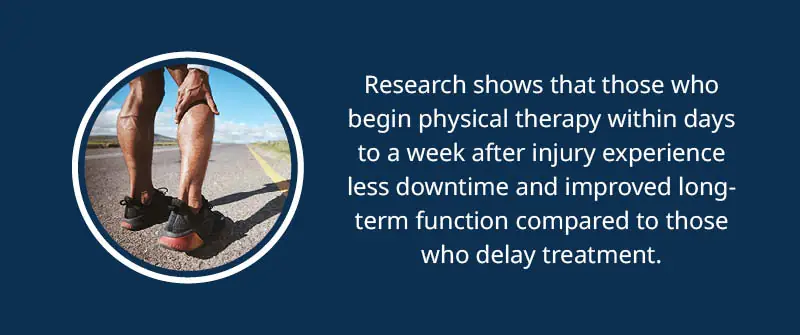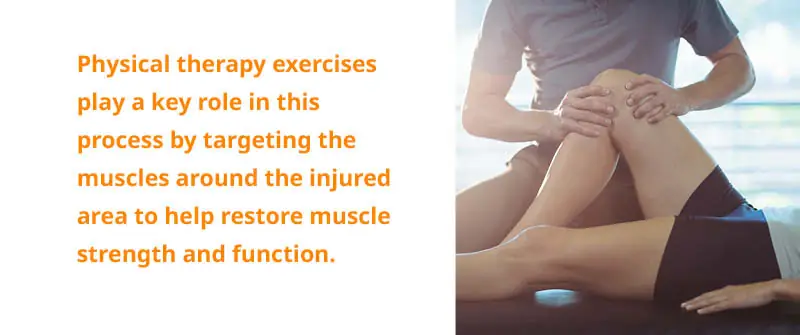
How Soon Should I Start Physical Therapy After An Injury?
Starting physical therapy after injury as soon as possible—once acute symptoms like severe pain and swelling have stabilized—has been proven to yield optimal recovery outcomes for most people. Early intervention allows your body to begin the healing process safely under professional guidance, helping to restore mobility, address pain, and prevent long-term complications. However, the exact rehabilitation timeline may vary depending on the type and severity of the injury, so it’s always best to consult an experienced therapist or physician soon after your injury.
How Soon After An Injury Should You Start Physical Therapy: Why Early Intervention Matters
When it comes to acute injury management, the timing of physical therapy can drastically affect your results. Engaging with a physical therapist in the early stages of therapy ensures that inflammation, pain, and swelling are controlled properly, reducing the risk of further damage and setting the stage for smoother recovery. At Bull City PT, our clinicians are dedicated to providing personalized evaluations shortly after injury, which means you won’t be left guessing about the right time to start. The early stages of therapy focus on gentle movement and pain-reducing modalities, preparing your body for more active rehabilitation as healing progresses, and delaying treatment can lead to worse outcomes or longer recovery times.
Starting physical therapy after an accident early can also enhance blood flow, which helps deliver nutrients and oxygen to the injured area and speeds up healing.
The Benefits Of Starting PT As Soon As Acute Symptoms Subside
Once severe pain, bleeding, or significant swelling has begun to resolve, initiating therapy can help you regain function faster, experience less pain, and minimize the risk of chronic pain or stiffness. For common injuries such as whiplash, back pain, or soft tissue strains, research consistently shows that those who begin physical therapy within days to a week after injury experience less downtime and improved long-term function compared to those who delay treatment. At Bull City PT, personalized treatment plans are developed for patients to target their specific recovery goals and promote effective healing. With Bull City PT’s comprehensive approach, you can expect a blend of gentle activation, education, and gradual progression tailored to your specific stage of healing.

Case Example: Immediate Vs Delayed Therapy Outcomes
Imagine two individuals who have sustained similar soft tissue injuries from a car accident. The first starts physical therapy at Bull City PT within a week and benefits from early intervention, while the second waits several weeks before seeking help.
The early intervention group often experiences quicker pain relief, improved strength, and better return to daily activities, while delayed therapy can result in muscle stiffness and even persistent limitations. Early action can be the difference between a short recovery and a long-term struggle, increasing the likelihood of full recovery and helping patients recover fully.
Specific Guidance For Car Accident Injuries
After a car accident, it’s especially important to seek a professional assessment as soon as it’s safe. Many accident-related injuries (like whiplash or soft tissue strains) may not fully show symptoms for hours or days, but starting physical therapy soon after the acute phase helps address underlying issues, such as mobility issues, and allows for the beginning of appropriate treatments before they become chronic. At Bull City PT, we understand the unique needs of physical therapy after a car accident and are equipped to guide you through early recovery, prioritize your safety, and optimize your return to activity.
In summary, if you are medically stable and acute symptoms are improving, don’t wait to consult with a physical therapy specialist. Early engagement, like that provided at Bull City PT, can make a powerful difference in your speed and quality of recovery by developing a treatment plan tailored to your specific needs.
How Long Do You Have To Wait To Go To Physical Therapy?
If you’ve recently been injured, you may wonder exactly how long you should wait before beginning physical therapy after injury. The simple answer is that the optimal waiting period depends on the type and severity of your injury, as well as the advice of a healthcare professional, such as your doctors or medical treatment team. For many injuries, you can start physical therapy as soon as acute symptoms such as severe pain or swelling have begun to resolve, while for more serious injuries—such as fractures—your body may require a longer period to stabilize before therapy can safely begin. Always consult your doctors to determine the right time to start rehab based on your specific medical treatment plan.
What Factors Influence The Waiting Period Before Starting Physical Therapy?
There is no one-size-fits-all timeline for starting physical therapy. Key factors that affect the waiting period include the type of injury, how severe it is, and how quickly your acute symptoms subside. For soft tissue injuries like sprains or muscle strains, getting evaluated as early as possible is beneficial; you might begin therapy within days to promote healing, restore range of motion, and prevent stiffness. However, for more complex injuries—like those involving broken bones—it’s essential to wait until you have medical clearance, usually after the initial healing phase. At Bull City PT, each patient receives a customized treatment plan based on their specific injury and recovery goals. Our therapists will assess your readiness based on a careful evaluation and coordinate closely with your physician if needed, ensuring treatment plans are tailored to the patient’s needs.
Typical Timelines For Different Injury Types
For many common injuries, such as whiplash, minor back pain, or soft tissue damage, physical therapy can often start within one to two weeks as soon as swelling has subsided and it is clear there is no severe underlying condition. Early movement and professional guidance can actually accelerate recovery and reduce complications like stiffness or loss of function. Physical therapy exercises play a key role in this process by targeting the muscles around the injured area to help restore muscle strength and function. On the other hand, for fractures, the timeline is determined by how quickly the bone knits together and achieves enough stability for safe movement. This is why a thorough physical therapist evaluation is crucial.

How Many Weeks Should You Wait To Start PT After A Femur Fracture?
Femur fractures require a more cautious approach. Typically, you need to wait several weeks—often between 6 to 12 weeks—before starting any significant physical therapy. This delay ensures the bone has healed sufficiently to tolerate movement and weight-bearing activities, reducing the risk of re-injury. However, even during this period, your physical therapist might guide you through gentle movement, muscle activation, and strategies to prevent stiffness or muscle wasting in adjacent areas, while also maintaining flexibility in the joints and supporting other tissues to prevent muscle atrophy. Once cleared by your physician, a comprehensive rehabilitation plan at Bull City PT will focus on rebuilding strength, mobility, and confidence.
The Importance Of Initial Medical Evaluation
Before beginning any physical therapy—especially after more serious injuries—an initial medical evaluation is essential. Physical therapists with extensive experience can accurately assess injuries, whether they occurred recently or long ago, ensuring that each patient receives a tailored treatment plan. This evaluation often includes imaging like X-rays for fractures or clinical tests for soft tissue injuries, ensuring that it’s safe to begin rehab. At Bull City PT, we partner with your care team to make sure your therapy timeline is personalized and safe, so you can confidently focus on your recovery without delay.
Can You Start Physical Therapy Too Soon?
Starting physical therapy too soon—or before your body is ready—can actually hinder your recovery rather than help it. While early intervention often accelerates healing for many injuries, initiating therapy during the acute phase, especially while active symptoms like severe swelling, pain, or bleeding persist, can place unnecessary stress on healing tissues, increasing the risk of scar tissue formation and reduced range of motion, and potentially delay your progress. Your physical therapist is trained to carefully assess your unique circumstances to determine the best time to begin treatment, ensuring safety and effectiveness for every stage of recovery.
The timing of physical therapy is crucial, especially in the initial days following an injury. If therapy begins before your injury has stabilized—for example, before a broken bone is set or significant swelling has reduced—you risk aggravating the injury and increasing the potential for long term complications. Signs that you may need to delay PT include persistent, severe pain, active bleeding, pronounced swelling, or if your overall medical status is still being assessed. This is particularly important for acute phase injuries or immediately after traumatic incidents like a fall or car accident. In such cases, a medical evaluation is essential to rule out complications that may require specialized treatment before rehabilitation begins.
What Are The Risks Of Early Physical Therapy?
Engaging in physical activity or intensive movement too soon after injury can lead to increased pain, inflammation, or even new damage to the affected area. Early mobilization may hinder bone healing in the case of fractures, prevent soft tissue from properly repairing, or cause joint stiffness to worsen. As a result, not only might your initial recovery period be extended, but you might also develop compensatory movement patterns that are difficult to correct later, potentially impacting your long-term outcomes.
How Do Therapists Decide When To Start?
At Bull City PT, our highly trained therapists conduct comprehensive assessments, including a review of your injury, symptoms, and overall health. This means you’re never asked to start PT too soon. Using clinical judgment and evidence-based guidelines, your therapist will look for markers of readiness, such as controlled swelling, manageable pain, absence of active bleeding, and stable vital signs. When necessary, your therapist will collaborate with your primary care physician to ensure you’re medically cleared for therapy. This careful approach allows us to tailor a plan that supports both immediate recovery and long-term function, preventing setbacks and fostering confidence in your rehabilitation journey.

Signs You Should Delay Physical Therapy
If you’re experiencing severe, unrelenting pain, have visible or uncontrolled swelling, or your injury hasn’t yet been fully diagnosed, it’s best to wait. Likewise, if your doctor has recommended a specific rest period for bone healing (as with certain fractures), adhering to this advice is critical. Rather than risking your progress by starting physical therapy too soon, take comfort in knowing that Bull City PT is dedicated to beginning your treatment only when it’s safe and effective, so you can focus on getting back to the active lifestyle you love with peace of mind.
What Happens If You Don’t Do Physical Therapy After An Injury?
Skipping physical therapy after an injury can significantly impact both short-term healing and your long-term well-being. Individuals who forego rehabilitation often experience slower recovery, persistent discomfort, and a greater risk of developing chronic pain or instability in the affected area. Over time, this can limit your independence, restrict daily activities, make it harder to recover and return to normal activities, and reduce your ability to enjoy life, increasing the likelihood of further injuries that could have been prevented with timely intervention.
What Are the Immediate Risks Of Skipping Physical Therapy?
In the initial phase following an injury, opting out of physical therapy may seem inconsequential, especially if symptoms appear to improve on their own. However, without expert guidance, improperly healed tissues can result in loss of functional mobility and flexibility, and can negatively affect the muscles by reducing their ability to function properly. Improper healing may also contribute to maladaptive movement patterns, muscle weakness, or joint stiffness. These issues make it harder to regain confidence in movement and, in some cases, may even prolong the healing process well beyond what’s typical with rehabilitation support.
Are There Long-Term Consequences To Avoiding Rehabilitation?
Avoiding rehabilitation increases the chances of lasting problems such as chronic pain, inflammation, and ongoing soreness or stiffness. For active adults, this could mean reducing participation in activities you once enjoyed, whether it’s running, biking, or even simple daily tasks. There’s also a higher risk of developing compensatory habits, like limping or favoring one side, which can lead to secondary injuries. Untreated sports injuries, in particular, can result in chronic pain and recurring problems that are difficult to resolve. Over time, conditions such as frozen shoulder, chronic low back pain, or recurring ankle sprains can develop, all of which may be significantly harder to treat if detected late.
How Does Timely Physical Therapy Prevent Setbacks?
Comprehensive and timely physical therapy is essential to restore normal movement patterns, rebuild strength, and safeguard against future injuries. A tailored therapy plan addresses not just the injured area but your overall wellness, teaching you the right exercises to safely rebuild endurance and stability. Attending regular physical therapy sessions and knowing when to start rehab are crucial for optimal results, as they ensure you perform the recommended exercise routines and progress safely. At Bull City PT, our compassionate team takes time to understand your goals and barriers, so you get support that’s perfectly matched to your needs. Early therapy ensures you return to your favorite activities with confidence and reduces the risk of persistent issues or surgical intervention down the road.
If you’re recovering from an injury, don’t let the fear of falling behind stop you from reclaiming your vitality. Bull City PT specializes in creating personalized rehabilitation paths for active adults, designed to accelerate healing, prevent complications, and help you move better than ever. Take the first step toward an empowered recovery: connect with Bull City PT today to experience expert care that’s with you every step of the way.






